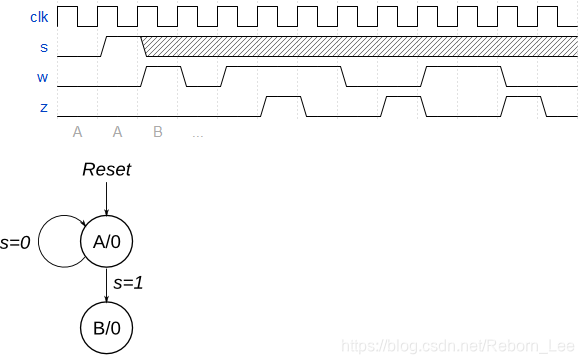本文共 6939 字,大约阅读时间需要 23 分钟。
目录
背景
这是这个系列中的一个状态机的题目,但是相比于给了你完整状态转移图之类的题目,这个题目还是稍微有点难的,我实在不知道该怎么给这个博客起个什么名字?
我在线等一个简单的方式去解决今天的问题,而如题所说,我用最无能的方式来解决这个问题,但简单的方式一定存在。
2019/12/16更新
今天一个帅兄弟给了我一个答案,很巧妙,这里十分感谢。我把它放到后面来给出。
原题复现
Consider a finite state machine with inputs s and w. Assume that the FSM begins in a reset state called A, as depicted below. The FSM remains in state A as long as s = 0, and it moves to state B when s = 1. Once in state B the FSM examines the value of the input w in the next three clock cycles. If w = 1 in exactly two of these clock cycles, then the FSM has to set an output z to 1 in the following clock cycle. Otherwise z has to be 0. The FSM continues checking w for the next three clock cycles, and so on. The timing diagram below illustrates the required values of z for different values of w.
Use as few states as possible. Note that the s input is used only in state A, so you need to consider just the w input.

我的方案
状态转移图
我的解决方案,有点无奈,多加了一些状态:

我的设计
根据此状态转移图给出我的设计:
module top_module ( input clk, input reset, // Synchronous reset input s, input w, output z); localparam A = 0, B = 1, S0 = 3, S1 = 4, S2 = 5, S3 = 6, S4 = 7, S5 = 8, S6 = 9, S7 = 10, S8 = 11, S9 = 12, S10 = 13, S11 = 14; reg [3:0] state, next_state; always@(*) begin case(state) A: begin if(s) next_state = B; else next_state = A; end B: begin if(w) next_state = S1; else next_state = S0; end S0: begin if(w) next_state = S2; else next_state = S4; end S1: begin if(w) next_state = S9; else next_state = S6; end S2: begin if(w) next_state = S3; else next_state = S5; end S3: begin if(w) next_state = S1; else next_state = S0; end S4: begin next_state = S5; end S5: begin if(w) next_state = S1; else next_state = S0; end S6: begin if(w) next_state = S7; else next_state = S8; end S7: begin if(w) next_state = S1; else next_state = S0; end S8: begin if(w) next_state = S1; else next_state = S0; end S9: begin if(w) next_state = S11; else next_state = S10; end S10: begin if(w) next_state = S1; else next_state = S0; end S11: begin if(w) next_state = S1; else next_state = S0; end default: begin next_state = A; end endcase end always@(posedge clk) begin if(reset) state <= 0; else state <= next_state; end assign z = (state == S10 || state == S7 || state == S3) ? 1 : 0; endmodule
测试成功。
更新方案
今天群里的大佬给了一种简单的方法,状态转移图确实简单了,但是理解起来呢?
我之前用的方案是在B之后的三个周期内,列举w的值,取值情况有8种,然后添加更多的状态去解决这个问题,不得不说状态转移图看起来复杂很多,也绝对不是推荐的方案。
我等待的确实是今天的这个方案,通过计数,不需要添加更多的状态,这也是我一开始就想用的方法,只是计数的时序当时没有搞定,今天很感谢,群里的一位兄弟。
直接给出设计,通过代码就应该能看出来设计的思路:
module top_module ( input clk, input reset, // Synchronous reset input s, input w, output z); parameter A = 1'b0, B = 1'b1; reg current_state; reg next_state; always@(posedge clk)begin if(reset)begin current_state <= A; end else begin current_state <= next_state; end end always@(*)begin case(current_state) A:begin next_state = s ? B : A; end B:begin next_state = B; end endcase end reg w_reg1; reg w_reg2; always@(posedge clk)begin if(reset)begin w_reg1 <= 1'b0; w_reg2 <= 1'b0; end else if(next_state == B)begin w_reg1 <= w; w_reg2 <= w_reg1; end else begin w_reg1 <= 1'b0; w_reg2 <= 1'b0; end end always@(posedge clk)begin if(reset)begin z <= 1'b0; end else if(next_state == B && counter == 2'd0)begin if(~w & w_reg1 & w_reg2 | w & ~w_reg1 & w_reg2 | w & w_reg1 & ~w_reg2)begin z <= 1'b1; end else begin z <= 1'b0; end end else begin z <= 1'b0; end end reg [1:0] counter; always@(posedge clk)begin if(reset)begin counter <= 2'd0; end else if(counter == 2'd2)begin counter <= 2'd0; end else if(next_state == B)begin counter <= counter + 1'b1; end endendmodule
巧妙之处在于将输入w延迟两拍之后进行判断,如果有两个w为1,则在下一个周期将输出z置位.
有的朋友,也许在状态机的设计中,习惯将第三段使用组合逻辑来实现,这个题目的第三段也可以使用组合逻辑,但是呢?确实也没有必要,因为状态机的第三段本身既可以使用组合逻辑,也可以使用时序逻辑,如果使用时序逻辑。
下面给出组合逻辑的方案:
module top_module ( input clk, input reset, // Synchronous reset input s, input w, output reg z); parameter A = 1'b0, B = 1'b1; reg current_state; reg next_state; always@(posedge clk)begin if(reset)begin current_state <= A; end else begin current_state <= next_state; end end always@(*)begin case(current_state) A:begin next_state = s ? B : A; end B:begin next_state = B; end endcase end reg w_reg1; reg w_reg2; always@(posedge clk)begin if(reset)begin w_reg1 <= 1'b0; w_reg2 <= 1'b0; end else if(next_state == B)begin w_reg1 <= w; w_reg2 <= w_reg1; end else begin w_reg1 <= 1'b0; w_reg2 <= 1'b0; end end reg z_mid; always@(*)begin if(reset)begin z_mid <= 1'b0; end else if(current_state == B && counter == 2'd0)begin if(~w & w_reg1 & w_reg2 | w & ~w_reg1 & w_reg2 | w & w_reg1 & ~w_reg2)begin z_mid <= 1'b1; end else begin z_mid <= 1'b0; end end else begin z_mid <= 1'b0; end end always@(posedge clk)begin if(reset)begin z <= 1'b0; end else begin z <= z_mid; end end reg [1:0] counter; always@(posedge clk)begin if(reset)begin counter <= 2'd0; end else if(counter == 2'd2)begin counter <= 2'd0; end else if(next_state == B)begin counter <= counter + 1'b1; end endendmodule
只需要将第三段改为组合逻辑,但是输出需要延迟一拍,为什么?看时序图。
FPGA/IC群推荐
有幸在这个群里认识了诸多俊杰,让我欣慰。
转载地址:http://xdcaf.baihongyu.com/